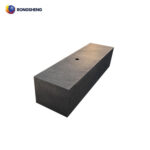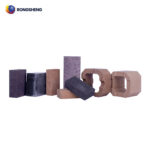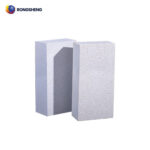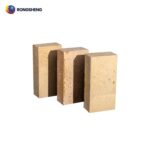How to Extend the Service Life of Blast Furnace Carbon Blocks?
The quality of self-baked carbon bricks, semi-graphite carbon bricks, microporous carbon bricks and ultra-microporous carbon bricks used in Chinese blast furnaces has reached the level of similar carbon bricks in foreign countries. Refractory manufacturers suggest that when selecting carbon bricks for blast furnaces, one should not place too much emphasis on the thermal conductivity coefficient alone, but should select comprehensive indicators such as <1μm pore volume ratio, thermal conductivity, compressive strength, air permeability, anti-iron corrosion index, oxidation rate, and alkalinity resistance. A comprehensive evaluation of carbon brick quality in strict accordance with industry standards can not only save production costs, but also increase the service life of blast furnace carbon blocks.
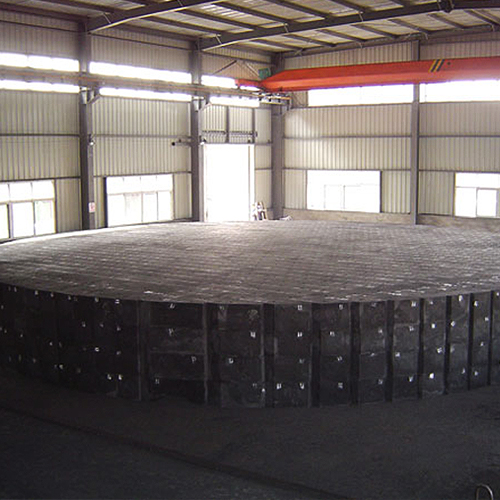
Advantages of Blast Furnace Carbon Blocks
Blast furnace carbon blocks have the following advantages:
- (1) Low linear expansion coefficient, thus having high volume stability.
- (2) Compressive strength does not decrease under long-term high-temperature operating conditions.
- (3) Good corrosion resistance under certain conditions.
- (4) Thermal conductivity is higher than clay bricks.
With the rapid development of blast furnace technology, the production process and physical and chemical indicators of blast furnace carbon bricks have also been rapidly developed and improved. With the rapid growth of my country’s steel production, blast furnaces have begun to develop towards large-scale. The smelting intensity of blast furnaces is getting higher and higher, and the quality of ordinary carbon bricks can no longer meet the requirements of blast furnace longevity. Since then, self-baking carbon bricks, semi-graphite carbon bricks, microporous carbon bricks, ultra-microporous carbon bricks and high thermal conductivity graphite carbon bricks have been developed successively, and the technology and quality of blast furnace carbon bricks have made great progress. At the same time, some companies have introduced high-quality carbon bricks for large blast furnaces. However, except for a few enterprises, most enterprises’ blast furnace longevity still has not reached the goal of 15 years of service life and 15,000 t/m3 of unit furnace capacity. This is related to factors such as construction quality and daily management, as well as inappropriate carbon brick material selection, excessive pursuit of single physical and chemical indicators, and unreasonable furnace structure.
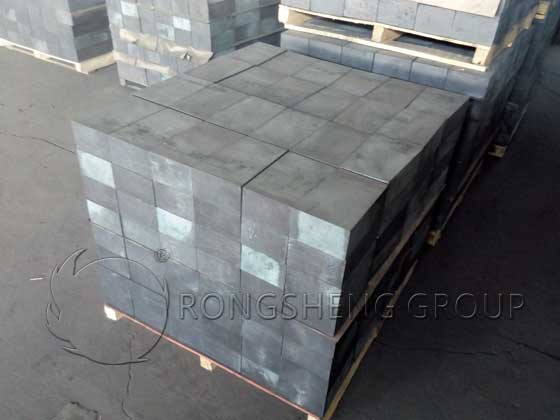
How to Extend the Service Life of Blast Furnace Carbon Blocks?
Blast furnace carbon blocks will be corroded during long-term use. The main reasons for the corrosion of carbon blocks are the penetration and erosion of molten iron and slag into carbon blocks, and the damage of thermal stress to carbon blocks.
The main ways to extend the service life of blast furnace carbon blocks are:
- (1) Produce blast furnace carbon blocks of different materials according to the needs of different parts of the blast furnace. For example, the furnace bottom adopts graphite-silicon carbide bricks and graphitized blocks with high thermal conductivity. The furnace bottom and furnace cylinder adopt blast furnace carbon blocks with high corrosion resistance. The keyway of the furnace bottom adopts blast furnace carbon blocks with higher strength.
- (2) Produce microporous carbon bricks with high thermal conductivity, strong alkaline resistance and low permeability. In the formula, electric calcined anthracite is used as the main raw material, and appropriate amounts of graphite fragments, silicon dioxide, silicon carbide or metallic silicon are added.
- (3) In order to reduce the gaps during masonry, the size of the furnace bottom carbon blocks should be as large as possible, such as large carbon blocks with a cross-section of 500mm x 600mm. If necessary, the furnace bottom carbon blocks should be impregnated once to increase the volume density of the carbon blocks and reduce the porosity.
- (4) In addition to using traditional extrusion-molded large carbon blocks, high-temperature hot molding carbon bricks can also be used in the furnace. This is also an effective way to extend the life of the furnace.
Comprehensive Review of Carbon Bricks for Blast Furnaces
Based on the damage investigation results of several blast furnaces using different types of carbon bricks, the main reasons for carbon brick erosion are as follows:
- (1) Molten iron penetration erosion. It mainly occurs at the bottom of the furnace and is related to the static pressure of molten iron on the carbon bricks. When the static pressure of molten iron is greater than 0.6 MPa, molten iron can easily penetrate into the gaps of carbon bricks >1μm and destroy the structure of carbon bricks. This type of erosion is mainly related to the carbon brick <1μm pore volume ratio, air permeability and other indicators. Therefore, the carbon bricks below the iron mouth of the furnace should be selected as true ultra-microporous carbon bricks with a pore volume ratio of <1μm greater than 80% and an air permeability of less than 5 mDa.
- (2) Looseness and powdering of the hot surface of carbon bricks. When the sum of the thermal stress and shear force on the carbon bricks exceeds the compressive strength, the carbon bricks are prone to ring cracking. The alkali metals, zinc and water vapor gas in the furnace penetrate into the cracks and react chemically with the carbon bricks, causing the carbon bricks to expand and become loose and powdered. This type of corrosion is mainly related to the thermal conductivity, compressive strength, oxidation rate and alkali resistance of carbon bricks. When the thermal conductivity of carbon bricks is increased to above 16 W/(m·K), the compressive strength is greater than 50 MPa, the oxidation rate index is <16% and the alkali resistance reaches good or excellent, the degree of looseness and powdering corrosion of carbon bricks can be effectively reduced.
- (3) Molten iron corrosion. If carbon bricks are in direct contact with molten iron, the ash content (including additives) in carbon bricks is too high and the molten iron corrosion index is low, carbon bricks are prone to molten iron corrosion. This type of corrosion is mainly related to the thermal conductivity and molten iron corrosion index of carbon bricks. When the thermal conductivity of carbon bricks is increased to above 16 W/(m·K), under the cooperation of an effective cooling system, slag iron shells are easily formed on the hot surface of carbon bricks, blocking the direct contact between carbon bricks and molten iron. When the molten iron corrosion index is <30%, preferably <25%, the melting rate of carbon bricks can be effectively slowed down.
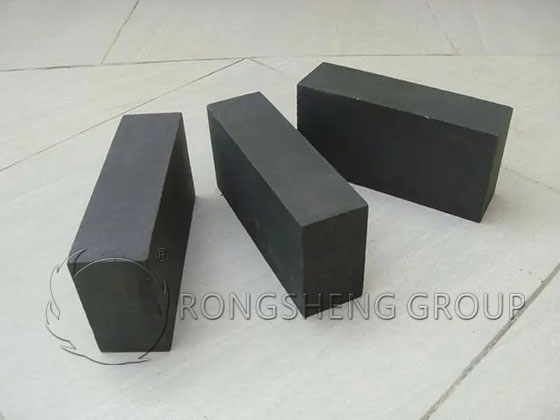
Therefore, the selection of carbon brick evaluation indicators should change the previous habit of over-emphasizing the single indicator of thermal conductivity. The order of evaluating carbon brick indicators should be <1μm pore volume ratio, thermal conductivity, compressive strength, air permeability, anti-iron corrosion index, oxidation rate, and alkali resistance. The quality of carbon bricks needs to be comprehensively evaluated in strict accordance with industry standards, and should not be overly biased towards a single indicator.
There is no specific standard for the ash content of carbon bricks in the current industry standards, but enterprises need to focus on monitoring the ash content of carbon bricks when selecting the quality of carbon bricks. For carbon bricks produced entirely with electric calcined anthracite as raw materials, the ash content is generally <10%. If the ash content of the carbon brick is >10%, it is often because some additives are added to the raw materials. Therefore, it is necessary to monitor the structure of the carbon bricks, detect whether SiO2 and metal Si fine powder generate SiC and β phase, detect whether Al2O3 and metal Al generate β phase, and whether the filler in the carbon brick voids appears flocculent.
At present, the development direction of carbon bricks is to improve the thermal conductivity and <1μm pore volume ratio index as much as possible. A variety of additives are often added to the raw materials to improve the resistance to iron erosion and micropore index. However, in the production process, it is necessary to fully guarantee the roasting temperature and roasting time to ensure that SiO2 and metal Si fine powder are all converted into SiC and β-SiO2 phases, and that Al2O3 and metal Al are completely converted into β phases and are evenly filled in the carbon brick voids.
According to the current production process, electric calcined anthracite is used as raw material and carbon bricks are produced by increasing the degree of graphitization. The thermal conductivity of carbon bricks can only reach 16-18 W/(m·K) at most. Some carbon brick manufacturers use a large amount of artificial graphite to increase the thermal conductivity. Since graphite has extremely poor resistance to molten iron corrosion, this type of carbon brick cannot be used in the furnace part that is in direct contact with molten iron even if the thermal conductivity is high. Therefore, it is not necessary for blast furnaces to pursue excessively high thermal conductivity of carbon bricks, but it is necessary to focus on the stability of the thermal conductivity of carbon bricks with temperature changes.
According to the structural form of the furnace, a gap of 60-80 mm is basically reserved between the cooling wall and the carbon bricks, and carbon bulk is used for tamping. Since the thermal conductivity of carbon ramming material can only reach 18 W/(m·K) at its normal working temperature environment. Therefore, carbon bricks do not need to have too high a thermal conductivity, otherwise the carbon ramming material will become a thermal resistance and affect the overall heat transfer effect of the furnace.

